Fall Vignettes from the Institute
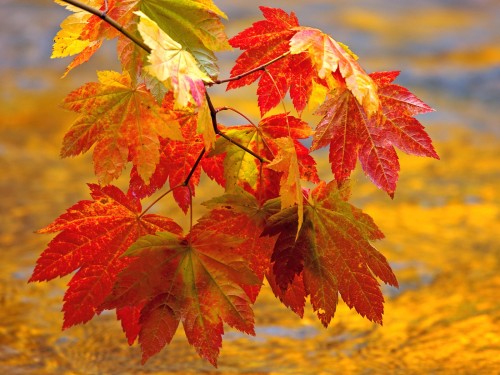
People experience the seasonal transformations of the natural world in a myriad of ways. Each of us may recognize subtleties taking hold of a landscape in times of change that others will miss completely because they have learned to pay attention to different details. Amidst downpours of rain in the lowlands and dustings of snow in the mountains, it can be easy to settle in to quieter and more thoughtful routines. It can be easy to put our noses in books and our feet in slippers, forgetful that these changes bring new forms of burgeoning and often unnoticed life back into the world.
For some, these changes affect most the olfactory realm, delighting that sense with smells of duff and rich, turning soils. For others, it is the sight of a golden larch contrasted against crystalline snow and mountain peaks, and still others notice most the mosses of the forest floor amplified to new shades of green by the quickening rains. Perhaps for some it is the elongated light and the shadows that persist which give new meaning to the color and character of the trees. Or some may simply feel it as an urgent knowing from deep within, a connection to the undercurrents of a timeless, cyclical change.
By combining our individual morsels of detail and thought about the essential elements of fall, we are able to paint a richer understanding of this place in which we live. We are able collectively to tell a story that captures the beauty of the changing seasons in the North Cascades ecosystem. In the process, we learn to draw on other’s knowledge in order to widen our own, ultimately coming to appreciate a more communal understanding of place. Below, staff and graduate students share their own unique vignettes of fall, offering perspectives of this region that span many seasons to just a few months.
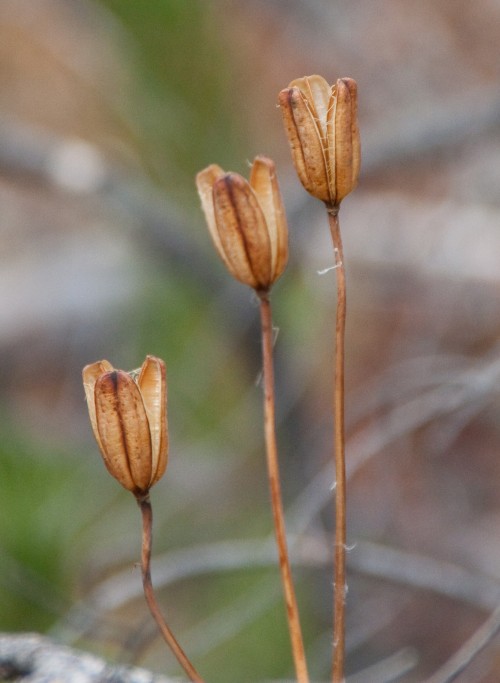 Tigerlily pods ready to sow their seeds on the fecund soils of the Methow Valley. Photo by Jess Newley.
Tigerlily pods ready to sow their seeds on the fecund soils of the Methow Valley. Photo by Jess Newley.
“Without a doubt… I experience fall through the changing colors.At the North Cascades Institute, I find the most vibrant colors in our vine maples. Bigger than shrubs but smaller than most trees, the vine maples have a very prominent presence in this ecosystem… evident now through the brilliant orange and red waves washing over the previously (solid) green forest. Because of the newfound hues, I find my senses challenged… with so many warm colors outside it’s hard to imagine that I’ll see my breath the moment I step outside. But perhaps that why we have such inspiring colors… to warm the heart.” – Katie Tozier, Graduate Student
“Near the 49th parallel, we see a dramatic shift in sunlight as winter approaches. The sun’s arc shrinks away toward the south, perforated by mountain peaks that don’t interrupt in summer. In the North Cascades, we start to see the spectrum of sunlight’s colors expand the yellows, oranges, and reds since the sun stays closer to the horizon. This optical phenomenon is known as ‘Rayleigh scattering‘. Photographers refer to it as ‘the golden hour’ because it is most common at sunrise and sunset. At latitudes near the poles, however, their cameras can catch striking hues throughout the day when the sun’s angle is low in the autumn sky. My favorite way to appreciate the broader gradient of color is to hike to the top of a mountain and bathe in the ambers, tangerines, and auburns that fuse with turning huckleberry leaves.” – Carolyn Waters, Park Ranger
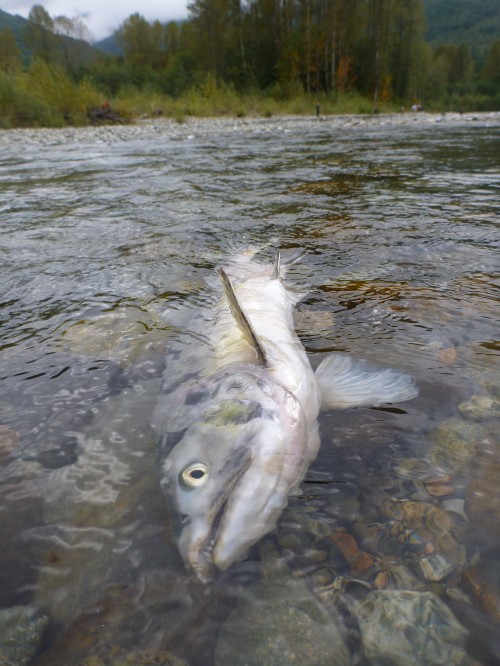 A tired salmon carrying its worn out, decaying body up the Skagit River to spawn. Photo by Jess Newley.
A tired salmon carrying its worn out, decaying body up the Skagit River to spawn. Photo by Jess Newley.
Larches. “Trees with needles shouldn’t be deciduous and yet these trees put on a magnificent rule-breaking display as they turn gold before shedding their needles in showers. Salmon. Fish shouldn’t swim upstream, let alone leap up waterfalls. Yet these fish will literally drive themselves to death reaching their home place. Alpine plants. Blueberries and mountain ash and heather, humble ground-dwellers releasing a blaze of iridescent blue, purple, crimson, gold, orange in a final botanical alpenglow across the rocks.” – Megan McGinty, Climate Challenge Programs Coordinator
“I have not experienced an entire autumn in the North Cascades, but what seems an ever-present reminder of fall is the snow that stubbornly remains on top of Colonial and Pyramid Peaks. Every day since moving to the Environmental Learning Center, I have looked up in awe at the rugged mountaintops that stand out so distinctly in the sky. Since the first snowfall way up high, I have noticed that the mountains are a constant reminder of the changing seasons – even during our warmest days, the snow stays there and keeps accumulating. On overcast days, the mountains blend in to the sky so much that I am sometimes taken aback to find them there! It’s an omen that more is to come – for better or worse, autumn is here!” – Ashley Kvitek, Graduate Student
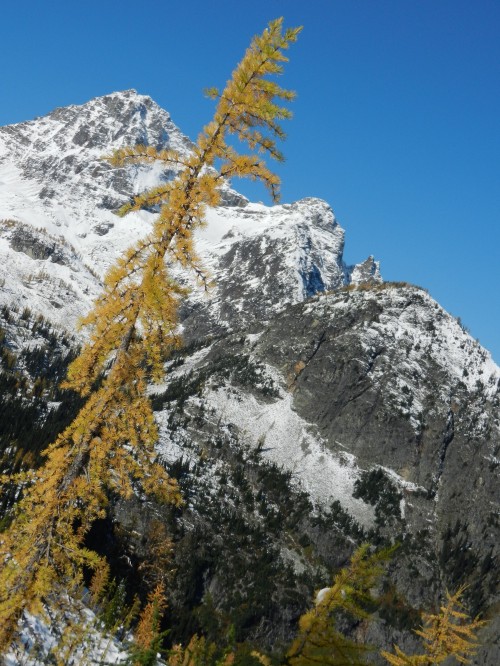 View looking north through turning larches from Maple Loop Trail on top of Washington Pass. Photo by Kiira Heymann.
View looking north through turning larches from Maple Loop Trail on top of Washington Pass. Photo by Kiira Heymann.
“Though it’s easy to regret the cold, darkening change of season, we must be open to the coming of new. Autumn is surprisingly filled with new life, especially here at the Environmental Learning Center. Sourdough and other forgotten creeks begin to flow, while the forest floor becomes home to a variety of mushrooms. The forest is painted back to life by many colors. Mosses become soaked with many shades of green. Vine and bigleaf maples begin to glow bright yellow, while the leaves of  some oregon grape become stained blood red. Douglas squirrels and townsend chipmunks become lively, collecting and stashing food in preparation for their friend Old Man Winter. Migrating birds pay their yearly visits to both the forest and Diablo Lake, while other year-round birds prepare for winter, including our recent curious, friendly visitor, the clark’s nutcracker. I find beauty in the simple changes and new life that each season brings.” – Matt Kraska, Education Intern
“The full force of fall rains, drumming away at the drier soils of summer, help tune us to the sounds of a new season. The winds whipping more freely through the thinning leaves of maple and alder are audible reminders of the shifting patterns of the forest. But it is the smell of the forest, not its sounds, that has me so caught up between the seasons. It’s almost as if the forest is brewing; as if the burnt duff and dried annuals of the summer have been steeping in the rain, and the air smells of its tea. Faint reminders of the fecund summer being lifted up one last time with the moist air before the cold sets in. The scent of the forest is different, and I know it is fall with every deep breath I take.” – Kiira Heymann, Graduate Student
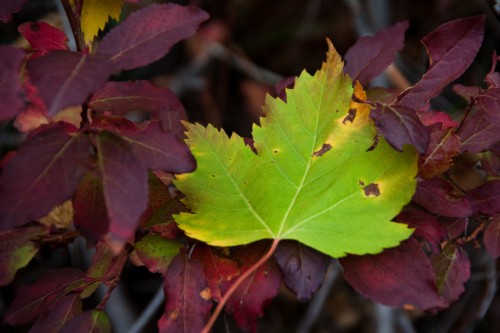 Douglas maple caught amidst the contrasting colors of fall. Photo Jess Newley.
Douglas maple caught amidst the contrasting colors of fall. Photo Jess Newley.
“When I moved to Washington three years ago, the seasons confused me. I had grown up associating fall with dry, brown leaves crunching under my feet. Here, fall is soft, quiet and green. It is possible to walk silently over wet leaves while listening to the patter of a light rain falling. Mosses regain their loft as they soak up moisture. Evergreen varieties of ground cover like salal, oregon grape and swordfern flourish, carpeting the forest floor in shades of green. Fall is when the forest comes alive again after the summer drought. Maybe we should start calling it “spring”.” – Tanya Anderson, Graduate Program Coordinator
“As the days get cooler and the scenery turns from green to red, I find myself looking out of my window in wonder at a season which I have yet to fully experience. Growing up in Southern California, the days often stayed warm through October and it felt as though the leaves stayed green throughout the autumn season as well. Since moving here to the North Cascades, I have begun to sense a whole new meaning to fall that is highlighted by the subtly changing colors of the maple trees.” – Sarah Bernstein, Graduate Student


Thank you for the wonderful, expressive picture/writing vignette of fall—a great word trip!!
I loved this blog! Thank you all.
Christen, What a talented group you have. Congrats to Kiira for the great shots. Super job of providing a broad perspective. love you, DAD
oh my gosh, this is so beautiful. the writing and the photos. thank you for sharing and for being up in that magical world!
I really need to find a place like this. I’m not quite sure how far north from San Diego I’d have to drive to do that. I just miss those trees chgianng colors so much. This outdoor lunch setting is simply perfect.